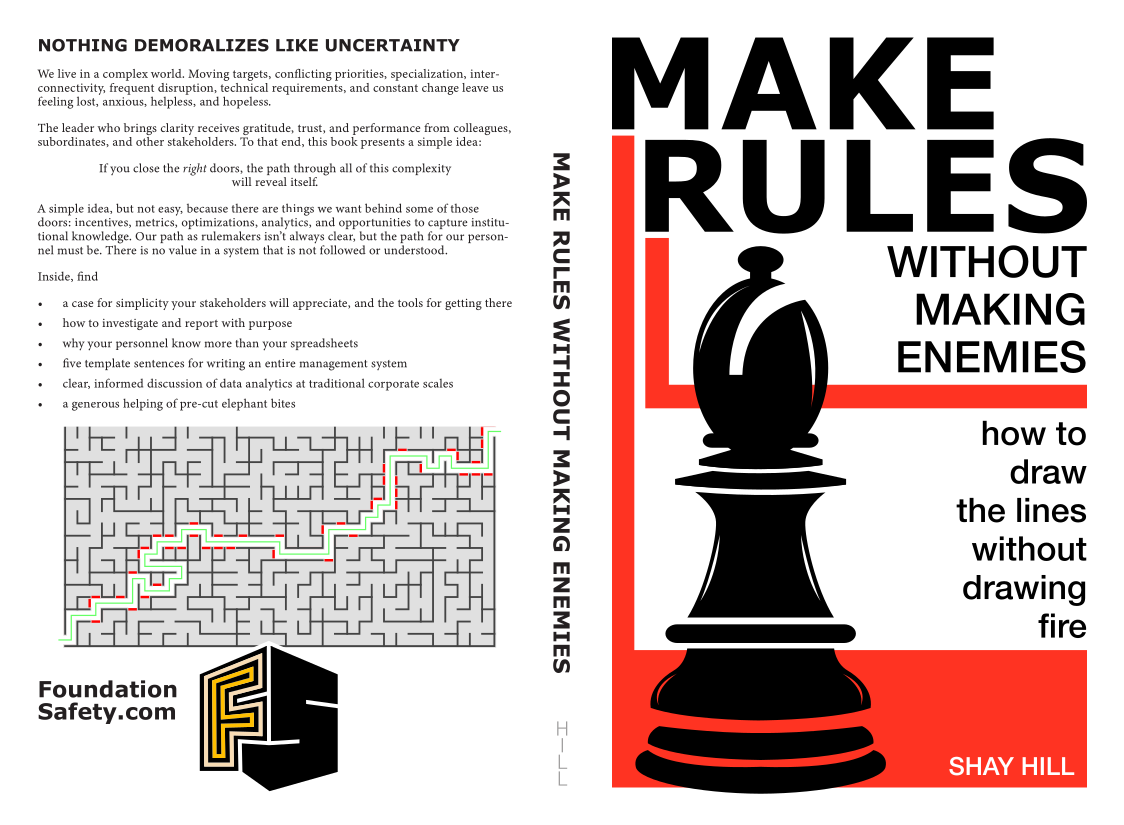NOTHING DEMORALIZES LIKE UNCERTAINTY
We live in a complex world. Moving targets, conflicting priorities, specialization, interconnectivity, frequent disruption, technical requirements, and constant change leave us feeling lost, anxious, helpless, and hopeless.
The leader who brings clarity receives gratitude, trust, and performance from colleagues, subordinates, and other stakeholders. To that end, this book presents a simple idea:
If you close the right doors, the path through all of this complexity will reveal itself.
A simple idea, but not easy, because there are things we want behind some of those doors: incentives, metrics, optimizations, analytics, and opportunities to capture institutional knowledge. Our path as rulemakers isn’t always clear, but the path for our personnel must be. There is no value in a system that is not followed or understood.
Inside, find
- a case for simplicity your stakeholders will appreciate, and the tools for getting there
- how to investigate and report with purpose
- why your personnel know more than your spreadsheets
- five template sentences for writing an entire management system
- clear, informed discussion of data analytics at traditional corporate scales
- a generous helping of pre-cut elephant bites
Chapter 1, The Path
A father and his young daughter walk together along a path through the forest. From time to time—as children will—the daughter wanders away from the path.
The father gently reprimands his daughter, reminding her repeatedly to stay on the path as instructed.
This has no effect, but the father is patient. Again gently, he reminds his daughter of the warnings he’s given her. “Do you remember, daughter, what I said would happen if you left the path?”
The daughter dutifully replies, “If I leave the path, I could get lost, and you would miss me very much.”
The father, hearing his own words repeated back to him, is confident that his daughter has listened and will now stay on the path.
But again, the daughter wanders away from the path.
Fortunately, the father has had some communication training. He starts by encouraging his daughter, “You’ve done very well on this walk. I know we are farther from home than we’ve ever been, but you’re being brave and strong, and I am proud of you.”
… before harshly—but unavoidably—leveraging her own fear against her.
Father: What would happen, daughter, if you lost your way?
Daughter: I wouldn’t know where to go.
Father: And how would you feel?
Daughter: I would be afraid.
Father: What would you be afraid of?
Daughter: That I couldn’t find my Daddy.
Father: What would happen if you never found your Daddy?
Daughter: I would miss him, and I wouldn’t know where to go.
Father: Where would you sleep?
Daughter: I don’t know.
Father: What could happen to a child in the forest after dark?
Daughter: …
Father: What could happen to me when I was looking for you after dark?
The daughter begins to sob, and the father stops, satisfied that his daughter, now adequately chastened, will stay on the path.
But again, the daughter wanders away from the path.
Now the father is gripped by his own fear. He is terrified that his daughter will be lost, possibly worse, if he cannot convince her to stay on the path.
He offers her a bribe establishes an incentive program.
Father: Here’s the deal, if you stay on the path, I will buy you a new toy. Would you like to have a new toy?
Daughter: I would love to have a new toy, Daddy!
Father: Then we agree, you stay on the path, and Daddy will buy you a new toy.
The father holds out his large hand, and the daughter shakes it, feeling quite grown up and responsible.
But again, the daughter wanders away from the path.
The father panics. He resorts to threats develops a performance improvement plan.
Father: If you leave the path again, I will take away your toys and throw them in the fireplace! Do you understand?
Daughter: Yes, Daddy.
Father: Then we’re clear? If you wander away from the path again, Daddy will throw all your toys in the fireplace.
To make sure, the father drafts an agreement. He removes a pen and paper from his backpack, then writes down the arrangement with two signature lines at the bottom. He signs the top line, then offers the paper to his daughter.
The father encourages his daughter to sign, but not before encouraging her to read the document aloud and answer a few follow-up questions to make sure she understands the agreement.
The daughter reads the document aloud, answers the questions, and signs, no longer feeling at all grown up.
The father didn’t want to go this far, but he’s confident that if his daughter can feel the same fear he’s feeling, she will “stick with the program” and make it home safe.
The daughter is indeed afraid and does not want her toys thrown in the fireplace, but she continues to stray from the path.
The father loses his temper. “What do I have to do to convince you? Don’t you care about yourself? Don’t you care about me? Do you want to be eaten by wolves? WHY WON’T YOU STAY ON THE PATH?!”
The daughter, terrified, replies tearfully, “Daddy, what is a path?”
What is a Path?
The daughter wanted to please her father and she wanted to keep her toys and she didn’t want to be eaten by wolves, but she couldn’t see the path.
It is the same with our front-line employees. They want to get paid, they want to be safe, they want to succeed, and they want the organization to succeed, but they still have to see the path. On too many unfortunate occasions, industry workers have literally died to succeed, to meet a deadline, or to please a mentor. So why do we have to work so hard for compliance with our management system?
The hard thing about following rules is that there so many of them:
- the rules in the management system
- the “rules” in the org chart
- the “rules” in the job description
- the “rules” in the training
- the “rules” of a trade
- the “rules” of social interaction and hierarchy
- the “rules” of professional advancement and reward
- the “rules” of productivity
- the “rules” of biology, focus, and mental health
- the “rules” of an 8-hour or 12-hour workday
It’s a lot to keep track of, and if you want the opportunity to follow a management system, you have to have a job, which means none of these rules can be ignored. As rule makers, we might believe that some of these rules are more important than others, but we don’t write rules for the unemployed.
If you read the introduction with the father and daughter walking through the forest, I will forgive you for believing “the path” in my analogy was the first rule set: the rules in the management system. That is our principal job, and a lot of this book is dedicated to it, but the rules are not the path. The path is how to follow all the rules.
Make Rules Without Making Enemies: How to Draw the Lines Without Drawing Fire is available at Barnes and Noble. You can review the publishing spreads (i.e., read the entire book for free) here.





